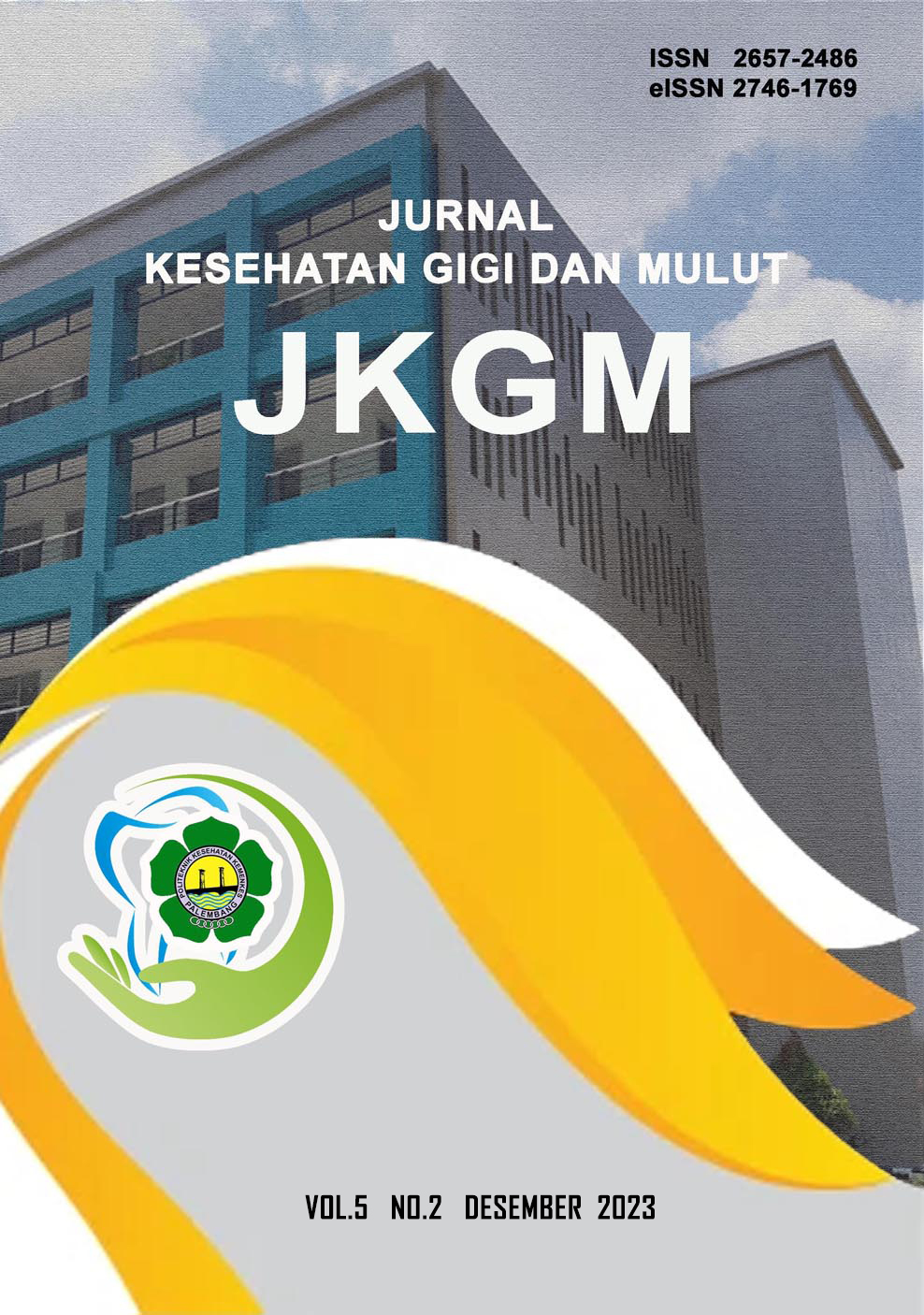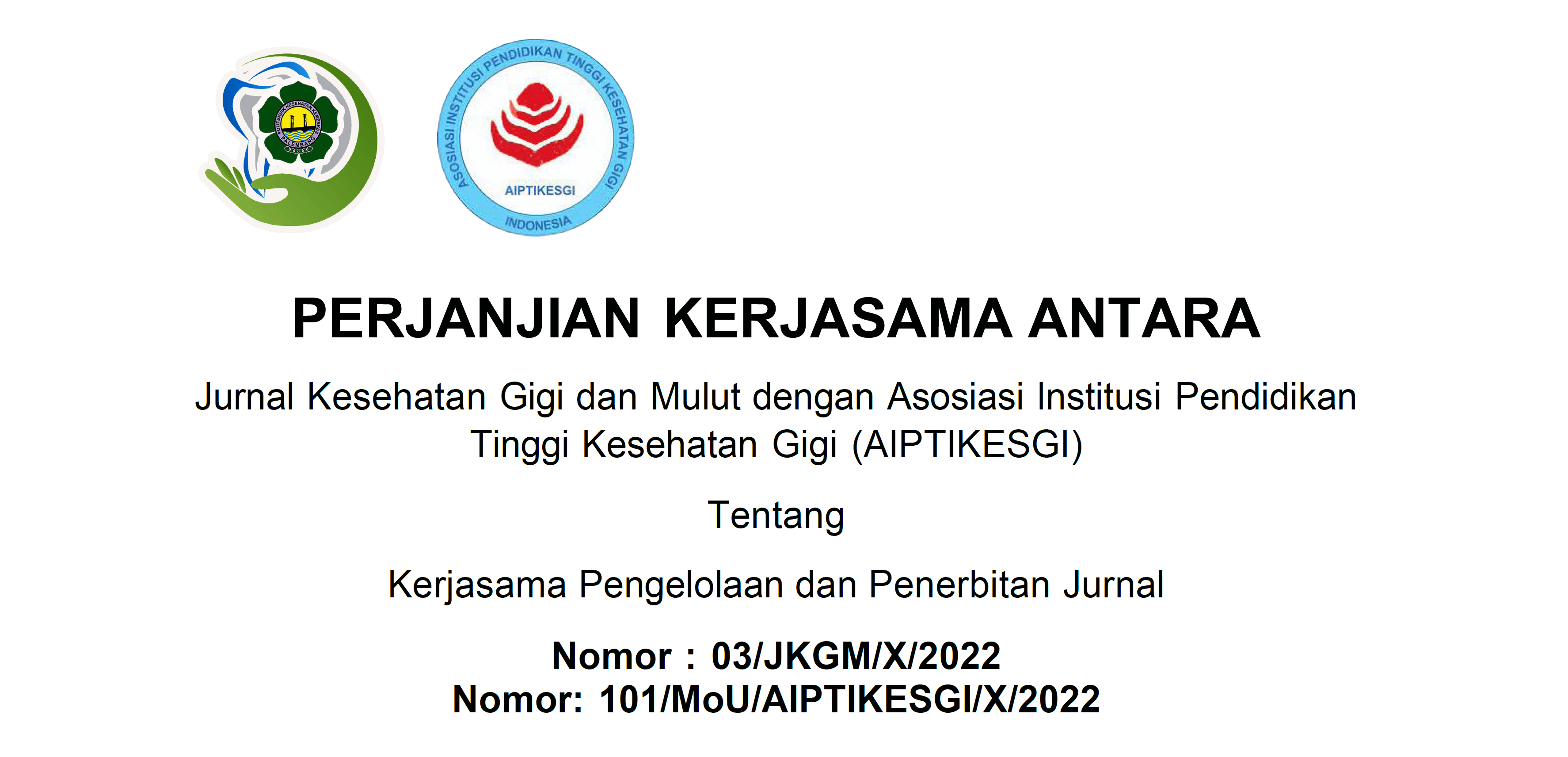HUBUNGAN STUNTING PADA ANAK DAN KARIES GIGI DI INDONESIA : STUDY LITERATURE
Abstract
Pendahuluan: Nutrisi adalah aspek penting dari Kesehatan. Stunting, sebagai indikator kekurangan gizi kronis, dapat mempengaruhi berbagai sistem tubuh, termasuk pertumbuhan dan perkembangan rongga mulut, serta berbagai penyakit dan gangguan gigi. Beberapa penelitian menemukan bahwa anak dengan kondisi stunting adalah: lebih mungkin mengalami karies gigi. Tujuan dari penelitian ini adalah untuk memetakan ruang lingkup penelitian yang ada mengenai hubungan stunting dengan karies gigi.
Metode: Penelitian ini memanfaatkan dua database mesin pencari (Scopus dan PubMed) dengan menggunakan kata kunci "stunting" dan "karies". Proses pemilihan artikel dilakukan mengikuti protokol Preferred Reporting Items for Systematic Reviews and Meta-analyses (PRISMA).
Hasil :Diketahui jumlah artikel yang meneliti tentang hubungan stunting pada anak dan karies gigi sebanyak 30 artikel, artikel yang paling banyak di teliti pada tahun 2023 sebanyak 9 artikel atau sebesar (30%) sedangkan artikel yang paling sedikit pada tahun 2020 yaitu sebanyak 3 artikel atau sebesar (10 %).Sebagaimana dinyatakan dalam bagian hasil, temuan studi tentang signifikansi hubungan antara stunting pada masa kanak-kanak dan karies gigi sangat bervariasi.
Kesimpulan: Stunting dan karies pada anak keduanya disebabkan oleh interaksi faktor risiko yang kompleks, termasuk pendidikan orang tua yang rendah, kualitas pola makan yang buruk, dan status sosial ekonomi keluarga yang rendah.
References
Achalu, P., Bhatia, A., Turton, B., Luna, L., & Sokal-Gutierrez, K. (2021). Sugary liquids in the baby bottle: Risk for child undernutrition and severe tooth decay in rural el salvador. International Journal of Environmental Research and Public Health, 18(1), 1–16. https://doi.org/10.3390/ijerph18010260
Atef, H., Aboulghar, H., Abdel-Raouf, R., Zeid, A. S., Elsebaie, E. H., Abdalaleem, S., & Amin, A. A. (2021). Development of a simple and valid nutrition screening tool for pediatric hospitalized patients with acute illness. F1000Research 2021 10:173, 10, 173. https://doi.org/10.12688/f1000research.51186.1
Athavale, P., Khadka, N., Roy, S., Mukherjee, P., Mohan, D. C., Turton, B., & Sokal-Gutierrez, K. (2020). Early childhood junk food consumption, severe dental caries, and undernutrition: A mixed-methods study from mumbai, india. International Journal of Environmental Research and Public Health, 17(22), 1–17. https://doi.org/10.3390/ijerph17228629
BAPPENAS. (2020). Pedoman teknis penyusunan rencana aksi tujuan pembangunan berkelanjutan (tpb)/ sustainable development goals (SDGs).
Boccolini, C. S., Lacerda, E. M. D. A., Bertoni, N., Oliveira, N., Alves-Santos, N. H., Farias, D. R., Crispim, S. P., Carneiro, L. B. V., Schincaglia, R. M., Giugliani, E. R. J., Castro, I. R. R. De, & Kac, G. (2023). Trends of breastfeeding indicators in Brazil from 1996 to 2019 and the gaps to achieve the WHO/UNICEF 2030 targets. BMJ Global Health, 8(9). https://doi.org/10.1136/bmjgh-2023-012529
Cetthakrikul, N., Topothai, C., Suphanchaimat, R., Tisayaticom, K., Limwattananon, S., & Tangcharoensathien, V. (2018). Childhood stunting in Thailand: When prolonged breastfeeding interacts with household poverty. BMC Pediatrics, 18(1). https://doi.org/10.1186/s12887-018-1375-5
Choi, S., Nah, S., Kim, S., Seong, E. O., Kim, S. H., & Han, S. (2022). A validation of newly developed weight estimating tape for Korean pediatric patients. PLoS ONE, 17(7 July). https://doi.org/10.1371/journal.pone.0271109
Cianetti, S. , L. G. , L. E. , R. G. , A. I. , P. S. , & P. L. (2017). Dental caries, parents educational level, family income and dental service attendance among children in Italy.
De Onis, M., Garza, C., Onyango, A. W., & Borghi, E. (2007). Comparison of the WHO Child Growth Standards and the CDC 2000 Growth Charts 1. In The Journal of Nutrition Symposium: A New 21st-Century International Growth Standard for Infants and Young Children J. Nutr (Vol. 137). www.who.int/childgrowth/en
Delgado-Angulo, E. K., Hobdell, M. H., & Bernabé, E. (2013). Childhood stunting and caries increment in permanent teeth: a three and a half year longitudinal study in Peru. International Journal of Paediatric Dentistry, 23(2), 101–109. https://doi.org/10.1111/J.1365-263X.2012.01229.X
English, L. K., Obbagy, J. E., Wong, Y. P., Butte, N. F., Dewey, K. G., Fox, M. K., Greer, F. R., Krebs, N. F., Scanlon, K. S., & Stoody, E. E. (2019). Timing of introduction of complementary foods and beverages and growth, size, and body composition: A systematic review. In American Journal of Clinical Nutrition (Vol. 109, pp. 935S-955S). Oxford University Press. https://doi.org/10.1093/ajcn/nqy267
Folayan, M. O., El Tantawi, M., Oginni, A. B., Alade, M., Adeniyi, A., & Finlayson, T. L. (2020). Malnutrition, enamel defects, and early childhood caries in preschool children in a sub-urban Nigeria population. PLoS ONE, 15(7 July). https://doi.org/10.1371/journal.pone.0232998
Habimana, S., & Biracyaza, E. (2019). Risk Factors Of Stunting Among Children Under 5 Years Of Age In The Eastern And Western Provinces Of Rwanda: Analysis Of Rwanda Demographic And Health Survey 2014/2015. Pediatric Health, Medicine and Therapeutics, Volume 10, 115–130. https://doi.org/10.2147/phmt.s222198
Humana Dietética, N. (2014). Revista Española de Spanish Journal of Human Nutrition and Dietetics O R I G I N A L. In Rev Esp Nutr Hum Diet (Vol. 18, Issue 3). http://medicine.
James, S. L., Abate, D., Abate, K. H., Abay, S. M., Abbafati, C., Abbasi, N., Abbastabar, H., Abd-Allah, F., Abdela, J., Abdelalim, A., Abdollahpour, I., Abdulkader, R. S., Abebe, Z., Abera, S. F., Abil, O. Z., Abraha, H. N., Abu-Raddad, L. J., Abu-Rmeileh, N. M. E., Accrombessi, M. M. K., … Murray, C. J. L. (2018). Global, regional, and national incidence, prevalence, and years lived with disability for 354 diseases and injuries for 195 countries and territories, 1990–2017: a systematic analysis for the Global Burden of Disease Study 2017. The Lancet, 392(10159), 1789–1858. https://doi.org/10.1016/S0140-6736(18)32279-7
Kinyoki, D. K., Osgood-Zimmerman, A. E., Pickering, B. V., Schaeffer, L. E., Marczak, L. B., Lazzar-Atwood, A., Collison, M. L., Henry, N. J., Abebe, Z., Adamu, A. A., Adekanmbi, V., Ahmadi, K., Ajumobi, O., Al-Eyadhy, A., Al-Raddadi, R. M., Alahdab, F., Alijanzadeh, M., Alipour, V., Altirkawi, K., … Hay, S. I. (2020). Mapping child growth failure across low- and middle-income countries. Nature, 577(7789), 231–234. https://doi.org/10.1038/s41586-019-1878-8
Muhoozi, G. K. M., Atukunda, P., Skaare, A. B., Willumsen, T., Diep, L. M., Westerberg, A. C., & Iversen, P. O. (2018). Effects of nutrition and hygiene education on oral health and growth among toddlers in rural Uganda: follow-up of a cluster-randomised controlled trial. Tropical Medicine & International Health, 23(4), 391–404. https://doi.org/10.1111/TMI.13036
Naidoo, S., & Myburgh, N. (2007). Nutrition, oral health and the young child.
Ndekero, T. S., Carneiro, L. C., & Masumo, R. M. (2021). Prevalence of early childhood caries, risk factors and nutritional status among 3-5-yearold preschool children in Kisarawe, Tanzania. PLoS ONE, 16(2 February 2021). https://doi.org/10.1371/journal.pone.0247240
Nurva, L., & Maharani, C. (2023). Analisis Pelaksanaan Kebijakan Penanggulangan Stunting: Studi Kasus di Kabupaten Brebes Analysis of Stunting Management Policy Implementation: A Case Study in Brebes Regency. In • Jurnal Kebijakan Kesehatan Indonesia : JKKI (Vol. 12).
Page, M. J., McKenzie, J. E., Bossuyt, P. M., Boutron, I., Hoffmann, T. C., Mulrow, C. D., Shamseer, L., Tetzlaff, J. M., Akl, E. A., Brennan, S. E., Chou, R., Glanville, J., Grimshaw, J. M., Hróbjartsson, A., Lalu, M. M., Li, T., Loder, E. W., Mayo-Wilson, E., McDonald, S., … Moher, D. (2022). [The PRISMA 2020 statement: an updated guideline for reporting systematic reviewsDeclaración PRISMA 2020: una guía actualizada para la publicación de revisiones sistemáticas]. Revista Panamericana de Salud Publica = Pan American Journal of Public Health, 46, e112–e112. https://doi.org/10.26633/RPSP.2022.112
Peres, M. A., D Macpherson, L. M., Weyant, R. J., Daly, B., Mathur, M. R., Listl, S., Keller Celeste, R., Kearns, C., Benzian, H., & Allison, P. (2019). Public Health Foundation of India, Plot No. 47, Sector 44, Institutional Area 18 Gurgaon.
Renggli, E. P., Turton, B., Sokal-Gutierrez, K., Hondru, G., Chher, T., Hak, S., Poirot, E., & Laillou, A. (2021). Stunting malnutrition associated with severe tooth decay in cambodian toddlers. Nutrients, 13(2), 1–15. https://doi.org/10.3390/nu13020290
Setiawan, A. S., Abhista, N., Andisetyanto, P., Indriyanti, R., & Suryanti, N. (2022). Growth Stunting Implication in Children: A Review on Primary Tooth Eruption. In European Journal of General Dentistry (Vol. 11, Issue 1, pp. 7–16). Georg Thieme Verlag. https://doi.org/10.1055/s-0042-1742357
Sheetal, A., Hiremath, V. K., Patil, A. G., Sajjansetty, S., & Sheetal Kumar, R. (2013). Malnutrition and its oral outcome - A review. Journal of Clinical and Diagnostic Research, 7(1), 178–180. https://doi.org/10.7860/JCDR/2012/5104.2702
Sokol, R. L., Qin, B., & Poti, J. M. (2017). Parenting styles and body mass index: a systematic review of prospective studies among children. In Obesity Reviews (Vol. 18, Issue 3, pp. 281–292). Blackwell Publishing Ltd. https://doi.org/10.1111/obr.12497
Susarla, S. M., Trimble, M., & Sokal-Gutierrez, K. (2022). Cross-Sectional Analysis of Oral Healthcare vs. General Healthcare Utilization in Five Low- and Middle-Income Countries. Frontiers in Oral Health, 3. https://doi.org/10.3389/froh.2022.911110
Tanner, L., Craig, D., Holmes, R., Catinella, L., & Moynihan, P. (2021). Does Dental Caries Increase Risk of Undernutrition in Children? Https://Doi.Org/10.1177/23800844211003529, 7(2), 104–117. https://doi.org/10.1177/23800844211003529
Ummah, A. K., & Mediani, H. S. (2023). Proximal Factors on Stunting Incidence in Toddlers in Indonesia and Developing Countries: Scoping Review. Jurnal Penelitian Pendidikan IPA, 9(7), 219–225. https://doi.org/10.29303/jppipa.v9i7.3984
UNICEF/WHO/Bank Dunia. (2023). Levels and trends in child malnutrition: UNICEF/WHO/World Bank Group joint child malnutrition estimates: key findings of the 2023 edition. https://www.who.int/publications/i/item/9789240073791
Vieira, K. A., Rosa-Júnior, L. S., Souza, M. A. V., Santos, N. B., Florêncio, T. M. M. T., & Bussadori, S. K. (2020). Chronic malnutrition and oral health status in children aged 1 to 5 years: An observational study. Medicine (United States), 99(18), E19595. https://doi.org/10.1097/MD.0000000000019595
Vilcins, D., Sly, P. D., & Jagals, P. (2018). Environmental risk factors associated with child stunting: A systematic review of the literature. Annals of Global Health, 84(4), 551–562. https://doi.org/10.29024/aogh.2361
Visioli, F., Marangoni, F., Poli, A., Ghiselli, A., & Martini, D. (2022). Nutrition and health or nutrients and health? International Journal of Food Sciences and Nutrition, 73(2), 141–148. https://doi.org/10.1080/09637486.2021.1937958
WHO. (2023a). Tracking the Triple Threat of Child Malnutrition. 1–32. https://www.who.int/publications/i/item/9789240073791
WHO. (2023b). Stunting prevalence among children under 5 years of age (%) (model-based estimates). https://www.who.int/data/gho/data/indicators/indicator-details/GHO/gho-jme-stunting-prevalence
Wicaksono, F., & Harsanti, T. (2020). Determinants of stunted children in Indonesia: A multilevelanalysis at the individual, household, and community levels. Kesmas, 15(1), 48–53. https://doi.org/10.21109/kesmas.v15i1.2771
Zaragoza-Cortes, J., Trejo-Osti, L. E., Ocampo-Torres, M., Maldonado-Vargas, L., & Ortiz-Gress, A. A. (2018). Pobre lactancia materna, alimentación complementaria y diversidad de la dieta, y su relación con la baja talla en comunidades rurales. Nutricion Hospitalaria, 35(2), 271–278. https://doi.org/10.20960/nh.1352
Copyright (c) 2023 Jurnal Kesehatan Gigi dan Mulut (JKGM)

This work is licensed under a Creative Commons Attribution-ShareAlike 4.0 International License.
Authors who publish with this journal agree to the following terms:
- Authors retain copyright and grant the journal right of first publication with the work simultaneously licensed under a Creative Commons Attribution License that allows others to share the work with an acknowledgement of the work's authorship and initial publication in this journal.
- Authors are able to enter into separate, additional contractual arrangements for the non-exclusive distribution of the journal's published version of the work (e.g., post it to an institutional repository or publish it in a book), with an acknowledgement of its initial publication in this journal.
- Authors are permitted and encouraged to post their work online (e.g., in institutional repositories or on their website) prior to and during the submission process, as it can lead to productive exchanges, as well as earlier and greater citation of published work













